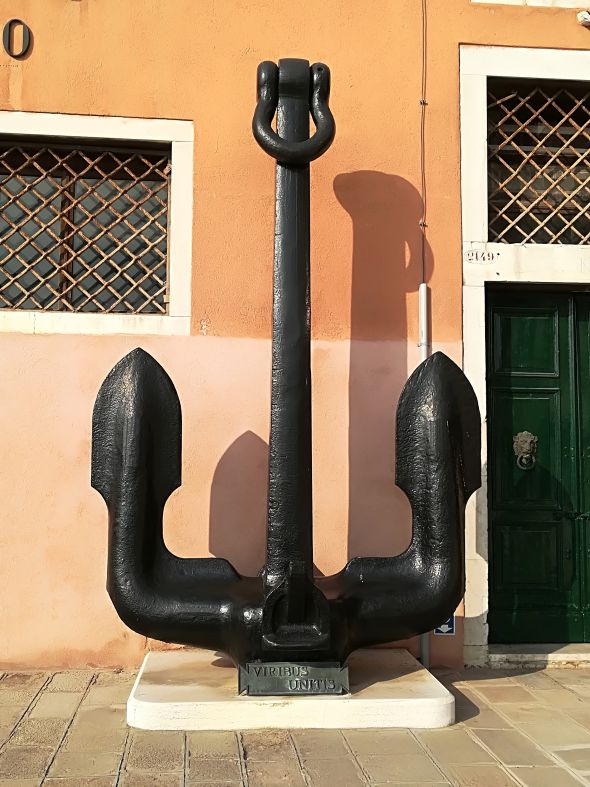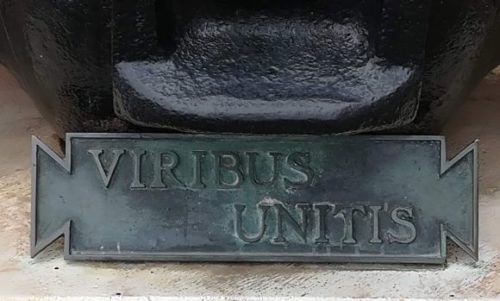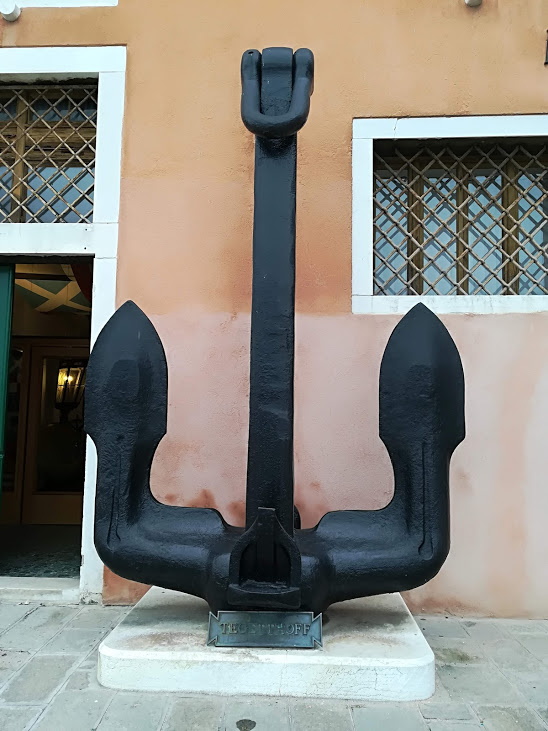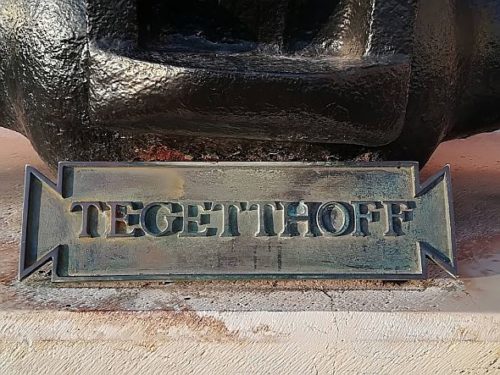Search results
2 results found.
2 results found.

I pick up the story of the column where I left it some while back, because there is one more bronze plaque to decipher.
To review: The granite column made for an Austrian admiral before World War I, when the Austro-Hungarian Empire was at the peak of its pride, was transported to Venice as spoils of war to commemorate the Italian victory in World War I. But, you may ask, what part did the Italian Navy play in said victory? The plaque shown below, which covers the front of the base, tells part of the story — the stately, official part. But the rockstar exploits, the ones that played an outsized role in the whole affair, have been omitted. I will now correct that oversight.
Beneath the disk which once contained the profile of Archduke Ferdinand Maximilian (and now vaunts the lion of San Marco), is this impressive screed. I know it’s annoyingly long (it’s an official document, so no mercy is shown), but please read it because otherwise the rest of this post won’t mean much.
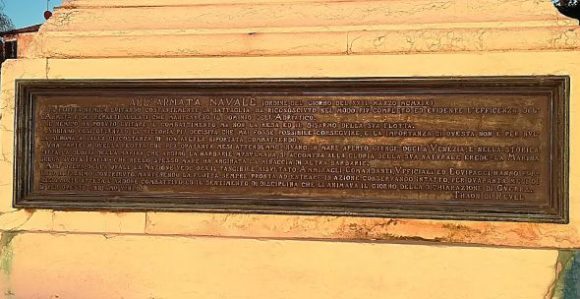
(Translated by me): To the fleet (Order 22 March 918) The enemy fleet, constantly avoiding battle, has recognized in the most complete and evident way the efficiency of the (Italian) fleet and of the Allied units which maintained control of the Adriatic. / The enemy was able to evade combat but not the surrender and the disarming of his fleet. / We have thus obtained the most decisive victory that could ever have been accomplished, and the importance of this is in no way damaged by the circumstance of not having achieved it in battle. / A part of that fleet that for 40 months waited in vain on the open sea today reaches Venice and in the historic city the glory of the navy which checked the Muslim barbarities joins the glory of her natural heir — the navy of the New Italy — that on the same sea checked the threat of other barbarities. / In the doing of which the nation now sees the tangible result. Admirals, commanders, officials, and crews have made the highest contribution maintaining the fleet always ready to enter in action. Conserving intact for 40 months of irritating waiting the combative ardor and the sentiment of discipline that stirred them on the day of the declaration of war. And it is for this that we have won. (signed Duke Paolo Camillo) THAON DE REVEL (admiral and commander of the Italian Royal Navy).
To summarize: “During 40 interminable, maddening months of constant patrol, our ships never got to fight because those pusillanimous Austrians didn’t come out and face us like men. But no matter! Our hardy seamen and equipment were always ready to take them on, and that’s a great thing and the reason why we won.” (This proclamation is a participation prize awarded by the admiral to console everybody for having missed out on combat.)
Don’t think, though, that the Italians were doing nothing but steaming back and forth across the Adriatic, scanning the horizon in vain. Four legendary feats proved that you don’t always need a big scary battleship to seriously damage your enemy; brains, skill, luck, and nerve — or as the saying here goes, “square balls” (coglioni quadrati) — can also get the job done. History shows that Venetian seamen and commanders often matched that description, and their Italian confreres weren’t far behind.
The master of all those qualities and protagonist of three of these deeds was Luigi Rizzo, born in Milazzo, Sicily, who became the most-decorated man in the history of the Italian Navy not only for his military talent but for his seeming inability to realize that he could ever get hurt. He and a few hardy colleagues dealt some very heavy blows to the ships, plans, and pride of the Austro-Hungarian navy. Their secret weapon, apart from their cog. quad., was their vessel, a type of small torpedo boat acronymed “MAS.”
First Exploit: On the night of December 9/10, 1917, Rizzo sank the battleship SMS Wien (pronounced VEEN, the Austrian name for Vienna) while it was at anchor near Trieste.
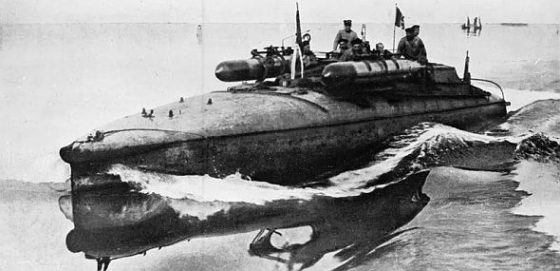
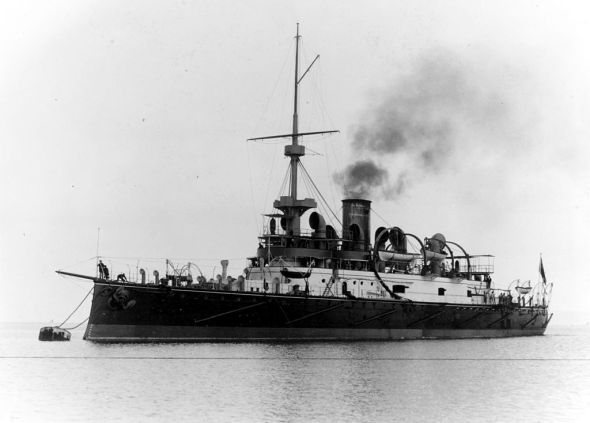
The Wien, with its sister ship Budapest, was in the Gulf of Trieste on November 16 to bombard Italian coastal defenses. Budapest and Wien opened fire at 10:35 AM and knocked out most of the Italian guns after about a half-hour. Efforts to counterattack by air or by torpedo boat were unsuccessful; the two ships then moved a few miles down the coast from Trieste to the Bay of Muggia, where they anchored and, I suppose, their crews drew deep breaths of satisfaction along with the smoke from freshly lit cigarettes. Not only were their ships big and strong, they were protected by seven steel chains strung at various depths across the harbor, so let’s not bother closing the watertight doors below. All was peace and tranquility; Rizzo had yet to be introduced.
As darkness fell on December 9, the two Italian MAS were towed into the bay of Trieste; towlines removed, the men started their silent electric engines and spent the next two hours cutting all the steel chains. Still undetected, at 2:32 AM they fired their torpedoes at Wien and Budapest. Budapest was unscathed, but Wien was hit: Rizzo’s two torpedoes blew a hole 10.5 meters (34 ft) wide abreast the boiler rooms, killing 46 men. Because all the watertight doors were open, the Wien capsized and sank in five minutes.
Both MAS were gone before being detected and Rizzo was awarded the Gold Medal of Military Valor. But this was no “star is born” moment — he had just received his third Silver Star for his actions at Grado during the Retreat from Caporetto (a mere month earlier), performing with what evidently was his hallmark attitude — “calm, serene, and scornful of danger.”
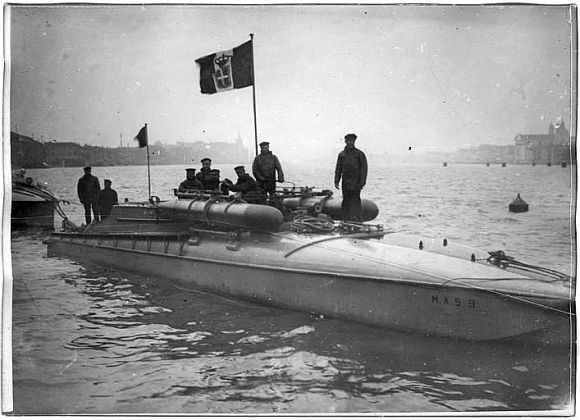
Wien was buried in the mud of the harbor bottom at a depth of 16.5 meters (54 ft); salvage of the ship was ordered on December 14, but soon abandoned. The immediate court-martial convicted Vice Admiral Alfred Freiherr von Koudelka, commander of the naval district, the captains of both ships, and the commander of the naval defenses of Trieste of failing to ensure that all possible precautions had been taken. “What — me worry?” is not a recommended military philosophy, especially if there’s a war going on.
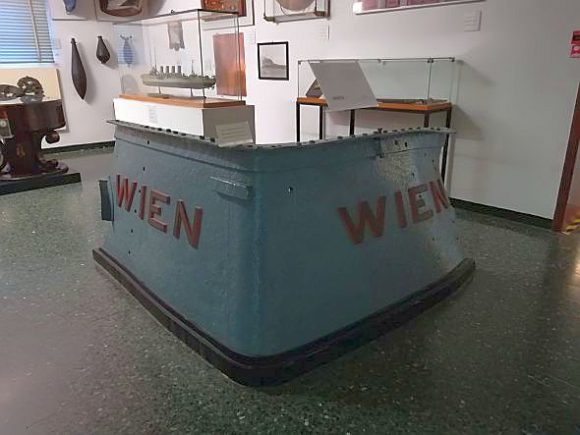
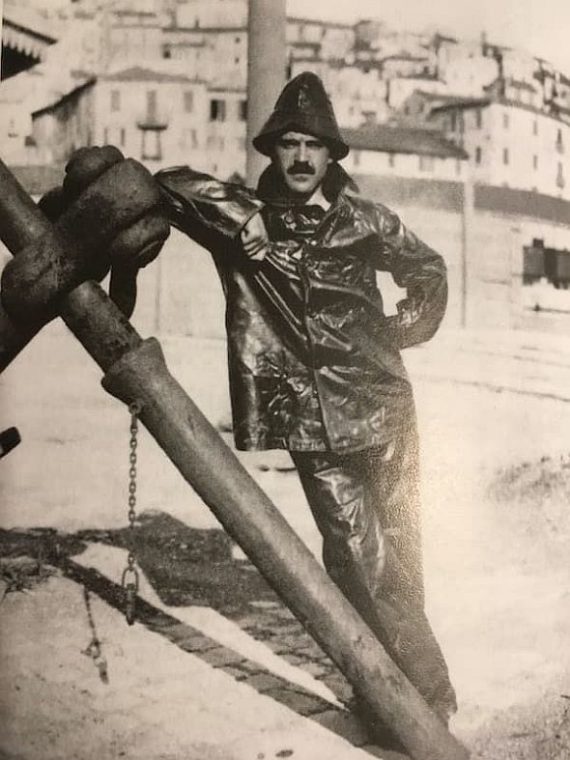
Second Exploit: On February 10, 1918, a mere two months after Wien went to the bottom, Rizzo joined what became the legendary raid on the Austrian ships in the bay of Buccari (now Bakar, Croatia), an adventure that almost immediately became known as the Beffa di Buccari (“the prank of Bakar”).
The basic idea would have been characterized as crazy, which was a huge advantage. As the town (and then-Austrian naval outpost for military as well as mercantile ships) lies at the end of a sheltered waterway 80 km (50 miles) long, it was commonly assumed that it was beyond attack. So naturally off we go.
Three MAS were organized under the overall command of Costanzo Ciano: #94 commanded by Andrea Ferrarini, #95 by Odoardo De Santis, and #96 commanded by Rizzo, which also carried poet and Air Force Major Gabriele D’Annunzio, the brain behind the whole affair.
Quite a flotilla departed Venice at 10:45 AM on February 10: Three groups of destroyers and Scout cruisers were assigned to tow and then support the nimble little MAS, just in case Austrian opposition was greater than anticipated.
Group 1 (one Scout ship and five destroyers) were positioned at Porto Levante on the Italian coast slightly south of Venice, ready to intervene if ordered to do so by central command in Venice.
Group 2 comprised three destroyers, each of which was to tow a MAS to within 20 miles west of the island of Susak, where each ship passed the tow line to a torpedo boat (torpediniere) and then moved to a spot 50 miles off Ancona to be on call for assistance to the MAS on their return.
Group 3 consisted of three torpedo boats, each of which towed a MAS to a mile from the entrance to the bay of Bakar.
There were also two submarines standing by, one 15 miles west of Pola, and another 15 miles south of Cape Kamenjak, guarding the escape route. What once appeared to me to have been just a batch of high jinks indulged in by a small group of bring-it-on guys was actually a mission running major risks which the Italian Navy intended to be ready to resolve. The assumption, based on aerial reconnaissance, was that there were military ships in the bay of Bakar.
As the convoy moved nearer the Croatian coast, Austrian sentinels ought to have given some kind of challenge. But once again, all was peace and quiet. If any lookout noticed the Italian ships in the winter darkness, he would have assumed they were Austrian, because how could they be anything else?
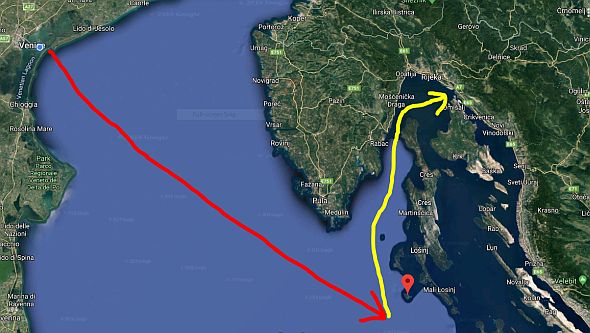

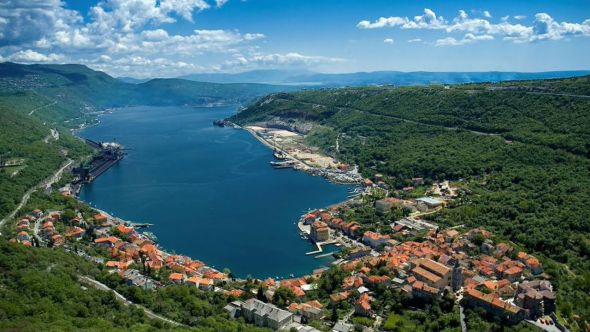
Still unrecognized by the Austrian coastal gun batteries, the three MAS continued until, a mile from the bay, they switched on their noiseless electric motors.
At 12:35 AM they reached the mouth of the bay of Bakar and saw their objectives — not warships, as they’d been informed, but three cargo steamships and one passenger ship. Never mind! MAS 96 (commanded by Rizzo) was assigned to attack ship #1, MAS 94 was given two, and MAS 95 headed for the fourth ship. At 1:20 AM the three boats launched their torpedoes.
I’ll skip the minute details. Of the six torpedoes fired, only one exploded (Rizzo’s, as it happened), which revealed that the ships were protected by anti-torpedo nets. As the alarms immediately began to blare, the MAS commenced to flee the bay past bewildered Austrian lookouts who even under the blinding floodlights didn’t shoot because they still couldn’t believe that the enemy had penetrated their harbor.
The lookouts at the entrance to the bay at Prestenizze managed to fire their rifles, to which the Italians replied, not with their machine guns, but with wisecracks; they even sarcastically slowed down.
But wait! Looking back, the Italian commanders couldn’t see the third MAS. THEY TURNED BACK, passing Prestenizze again. The search was fruitless — the missing craft had escaped on its own — so they turned around and passed the lookout point a FOURTH time, tossing three bottles into their wake as they made for Ancona. The three MAS reached the port at 7:45 that morning, uninjured though possibly somewhat disappointed.
But only “somewhat,” because the intrepid crews had fulfilled part of their mission. They had left a message in those three floating bottles sealed with the red, green and white of the Italian flag. It was D’Annunzio at his most taunting, giving what today would be called a very sick burn.
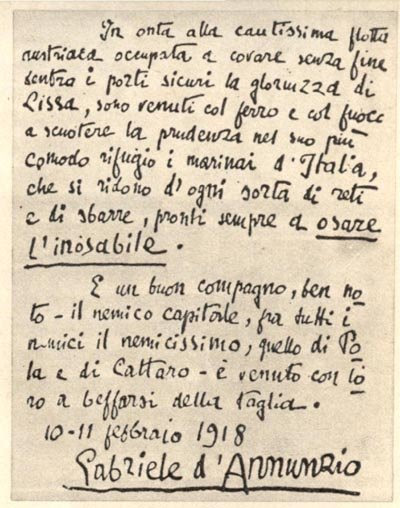

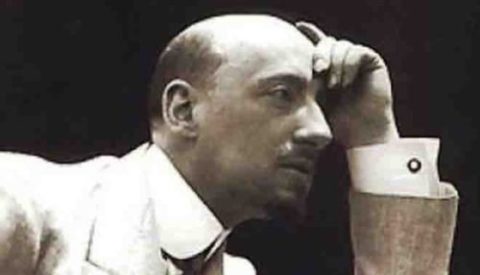
Unexploded torpedoes faded into insignificance in the face of this fabulous feat. Brief as it was, making fun of the Austrians in their own harbor had a tremendous psychological effect on the Austrians (humiliation) and even more on the Italians (invigoration) after the profound demoralization that followed the disaster of Caporetto. D’Annunzio became a national hero.
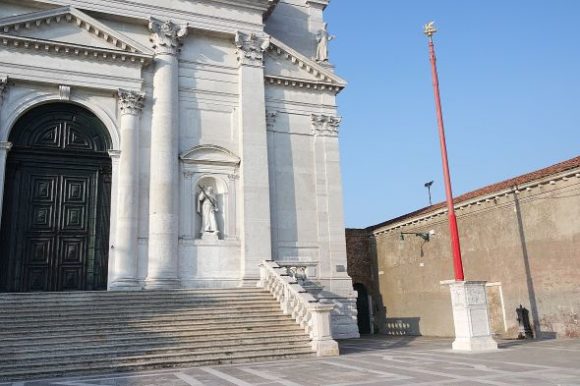
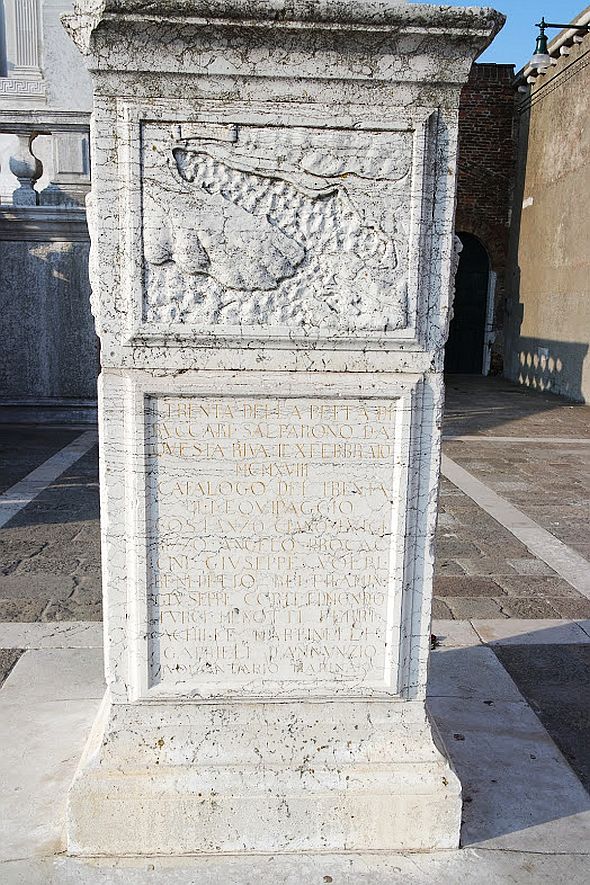



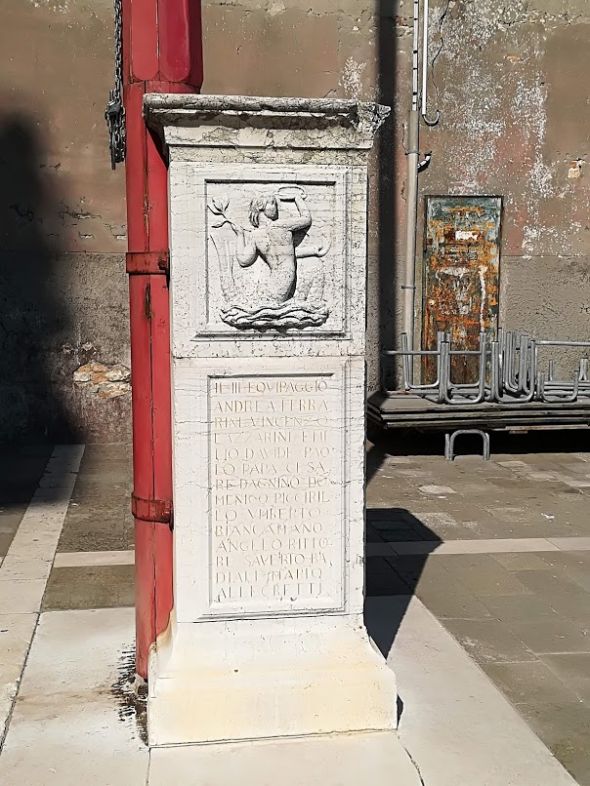
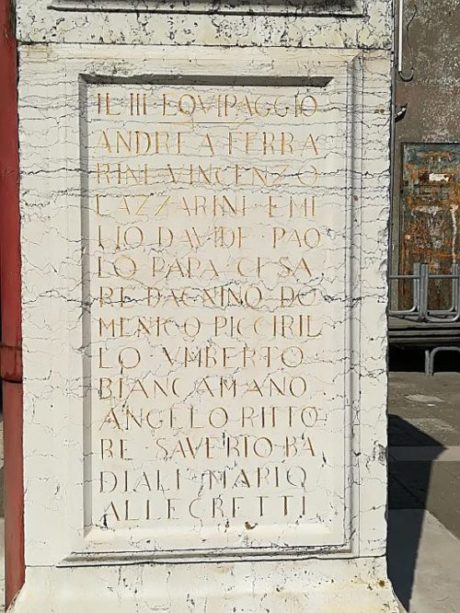
A certain Giacomo Scotti, in his book “Disertori in Adriatico,” has cast doubt on the glory of this event, pointing out that the ships in the harbor weren’t military, and accusing D’Annunzio of having cleverly managed to transform a failure into a resounding success (which he totally did). I have now shared Mr. Scotti’s opinion, and move on, because the one incontrovertible fact is that whatever D’Annunzio and his Thirty did on that freezing February night — danced a hornpipe in kilts, sang barbershop quartets, threw Slinkies at each other — they got through the Austrian defenses (if one can call them that) and made it home, thereby giving such a shot to Italian morale that eight months later Italy drove the Austrians out of the country once and for all.
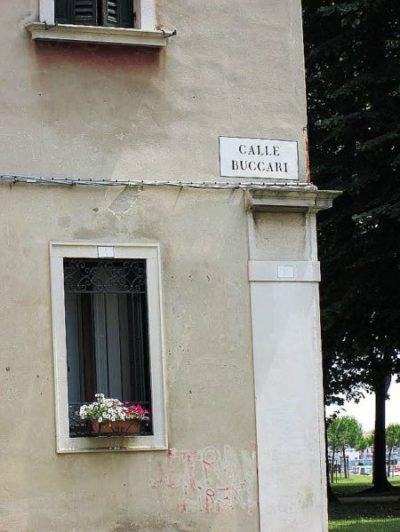
Rizzo was awarded a bronze star (changed to a silver star at the end of the war) for his part in this adventure. Then he got back to work with his MAS and his torpedoes — details to come.
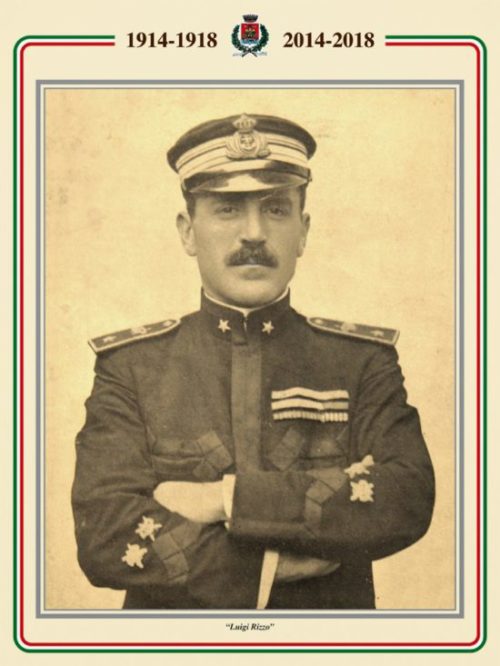
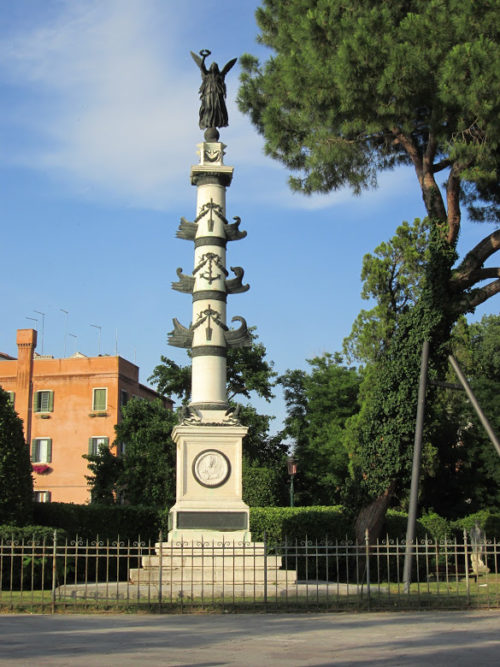
Lately I’ve set aside the subject of Italian naval triumphs in World War 1, but I can’t conclude my exegesis of Thaon de Revel’s document on the Victory Column without mentioning two of the most prodigious Italian naval exploits. It may not surprise you to learn that the extraordinary Luigi Rizzo was involved in the biggest one of all: The “Impresa di Premuda.” There is a reason why he came to be nicknamed “L’affondatore” (the Sinker, as in: He Who Sends Ships to the Bottom).
I’m not proposing that we dwell on the past, nor that we conduct a ceremony every day, but some things deserve to be stored somewhere further forward in our brains.
Third Exploit: The “Impresa di Premuda.” After the Beffa di Buccari, Luigi Rizzo was promoted to capitano di corvetta (lieutenant commander in US naval rank) and went back to his normal military duties. I doubt, though, that he gave any thought to his next assignment, or that it would launch him to more fame, more medals, and the establishing of the date, June 10, as the annual Navy Day. All this happened near Premuda, a Croatian island northwest of Zadar.
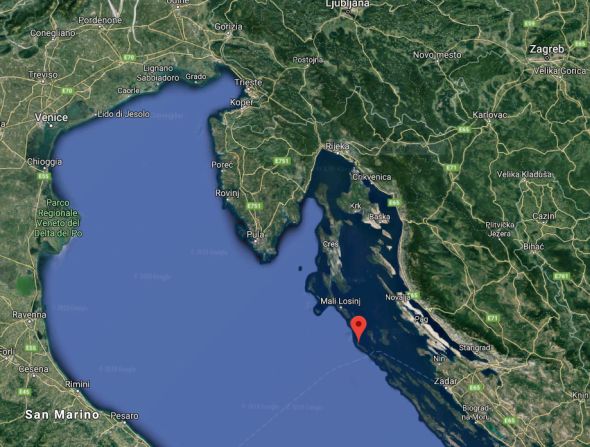
To set the scene: If the Italian navy had spent months patrolling the Adriatic without encountering an enemy ship, as per the remark on the Column, the Austro-Hungarian navy (I’ll just call it Austrian, for simplicity) hadn’t been much more productive.
The Allied forces had created a blockade across the Otranto Channel in 1915, and it effectively trapped the Austrians, keeping their 119 warships out of the action in the Mediterranean. (I will anticipate military experts’ comments by saying I’m aware that submarines were able to elude the blockade and were annoyingly effective at disrupting shipping. But both sides wanted to see something more decisive occur.)
On March 1, 1918, Admiral Miklos Horthy assumed command of the Austrian fleet; Thaon de Revel, the Italian admiral, correctly perceived this change as signifying some new plans, and that they would almost certainly have something to do with the blockade.
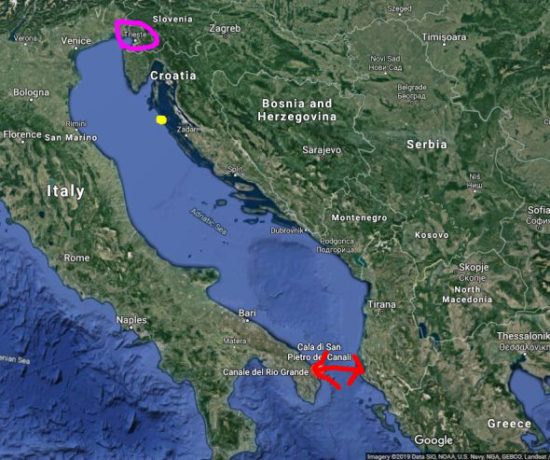
The Allied blockade had been a line of ships stretching 45 miles (72 km) from Brindisi to the Albanian coast just north of Corfu’. Battles and skirmishes ensued –the blockade was attacked 19 times — but the situation remained unresolved until 1918, when the Allies managed finally to stretch a physical blockade of nets and buoys across the entire channel. The Austrians had had enough, and were determined to settle the matter.
So in June, 1918, Admiral Horthy decided to dedicate most of his fleet to an all-out attack on the blockade. I won’t list all the components, which were many, but the stars of the operation were four monster dreadnoughts, the largest and most modern yet constructed: Tegetthoff and Szent Istvan (Santo Stefano) together with an escort, and Prinz Eugen with Viribus Unitis deployed nearby. What could possibly go wrong?
At 10:30 PM on June 8, the Austrian fleet left its safe harbors and began steaming down the Adriatic toward their intended surprise attack. They were a little behind schedule, but everything was going well until 3:00 AM on June 10 as Szent Istvan and Tegetthoff neared the island of Premuda. Luigi Rizzo saw them first.
Rizzo, together with MAS 21 (Giuseppe Aonzo commanding) was at the end of a routine patrol; his orders were to stay near Premuda until 2:00 AM on June 10, and after dawn to rejoin his support destroyers. They, like their commanders, knew nothing of the Austrian fleet’s approach (hence “surprise,” as noted).
At 3:15 AM, the Austrian convoy began to traverse the zone that the two MAS had been patrolling, at which point Rizzo descried, through the darkness, an enormous cloud of black smoke. He immediately realized it had to be coming from enemy ships. As he reported later, “I decided to profit by the uncertain light to prevent an attack and so I reversed my course, followed by MAS 21, toward the enemy. As I got closer, I realized that we were dealing with two huge ships escorted by 8 to 10 destroyers…”.

Did Rizzo contact his superiors to request orders? Did he call a committee meeting to discuss options? Did he ask himself if he was dreaming? Of course not. As he said, he turned around and began to move toward them, slowly, to avoid creating any telltale white wake, aiming straight between the two destroyers at the head of the convoy which were protecting Szent Istvan and Tegetthoff.
Naturally no Austrians had been on the lookout for any insane little Italian torpedo boats, so Rizzo managed to get as close as 300 meters (984 feet) from Szent Istvan‘s starboard side when he launched both of his torpedoes. They struck mortal blows to the massive ship; water penetrated the engine rooms at bow and stern and fire broke out in the boiler room. As Rizzo fled, the nearer destroyer immediately opened fire and began to pursue him; Rizzo, out of torpedoes, launched two anti-submarine bombs, one of which exploded and the destroyer desisted.
Aonzo, on MAS 21, was less fortunate; his torpedo struck Tegetthoff, but didn’t explode. But he too escaped the pursuing destroyer.
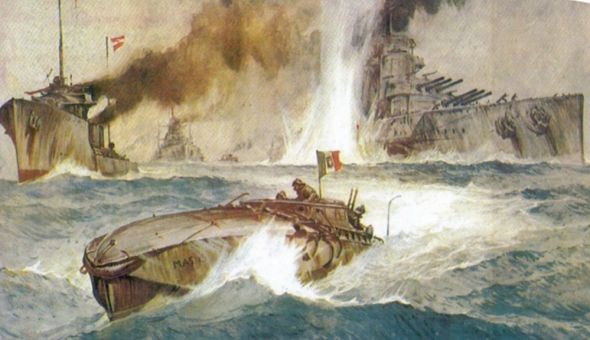
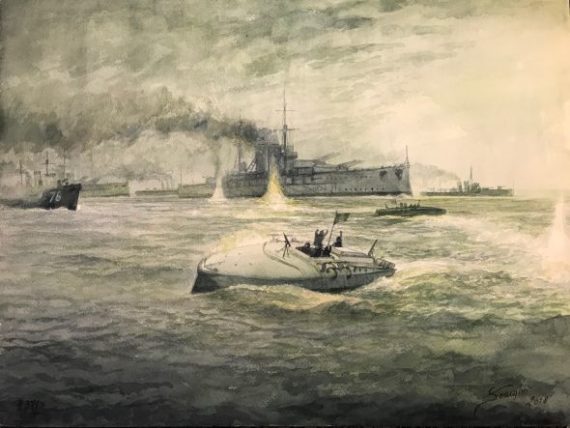
At 6:05 the 21,700-ton Szent Istvan, pride of the Austrian navy, began to list and after desperate attempts to keep her upright, finally capsized and sank beneath the waves.
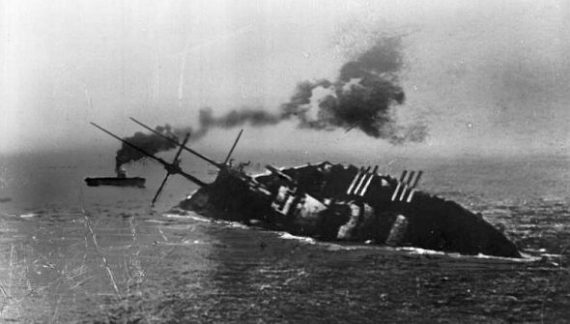
https://www.youtube.com/watch?v=fYkMGom8KSg
At 7:00 AM the two MAS were in Ancona and the secret enemy attack was no longer a secret. Seeing that the Austrians had been counting on surprise as their greatest weapon, Admiral Horthy ordered the entire convoy to turn and head back toward home and safety. The Tegetthoff reached Pola at dawn the following day, June 11, and the squadron accompanying Viribus Unitis/Prinz Eugen pulled in at 7:00 PM. For the Austrian fleet, the war was over; the stunning psychological blow meant that their ships never left port again.
Let me pause to let all that sink in. A couple of men and two little boats not only brought the Austrian fleet to a complete halt, they thereby altered the Allied naval plans and operations in the entire Mediterranean. Not as dramatic as an all-out battle, but they got the job done in less time and with a lot less waste of everything.
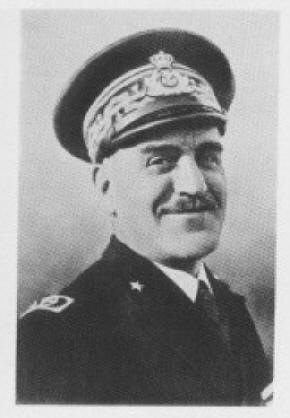
Rizzo was honored by the King of Italy with the Knight Grand Cross of the Military Order of Savoy, but because of his republican ideals he politely declined. He was decorated instead with the Gold Medal of Military Valor (not his first), and reported for duty the next day, I expect.
By the time his career concluded in 1941 he had risen to the rank of admiral, and had been given the victory title of Count of Grado and Premuda. France awarded him the Croix de guerre and made him a knight of the Legion of Honor; the United Kingdom bestowed the Distinguished Service Order; the United States gave him the Navy Distinguished Service Medal.
But it gets better. Admiral Miklos Horthy, commander-in-chief of the Austrian fleet in World War 1 and leader of the convoy headed by the Szent Istvan, became Regent of the Kingdom of Hungary, and awarded Rizzo the Royal Hungarian Order of Saint Stephen. Worthy adversaries, both of them.

Fourth Exploit: The “Impresa di Pola.” This feat does not involve Luigi Rizzo, but don’t stop reading because of that.
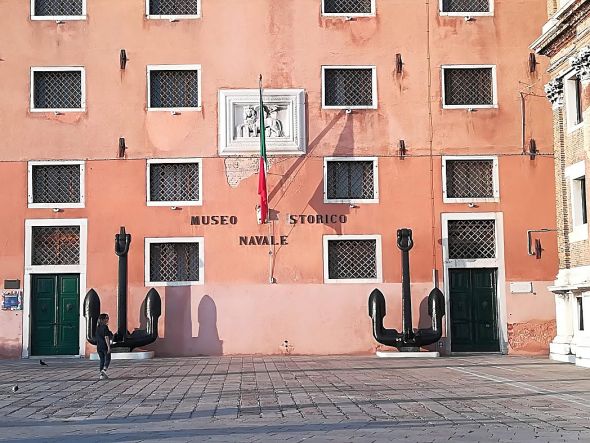
To recapitulate: After Rizzo put paid to the entire Austrian fleet, the three remaining monster battleships of the failed June expedition were harbored in Pola. As 1918 progressed, the Austrian government began to focus on the prospect of defeat, and on October 31 officially transferred Viribus Unitis, renamed Yugoslavia, to the newly formed State of Slovenes, Croats and Serbs in order to avoid having to surrender the ship to the Allied powers.
Their satisfaction in so cleverly depriving the enemy of this prize was short-lived, because 24 hours later two dauntless Italian naval officers slipped into the harbor at Pola and rendered the magnificent vessel, bearing whatever name you want, null and void.
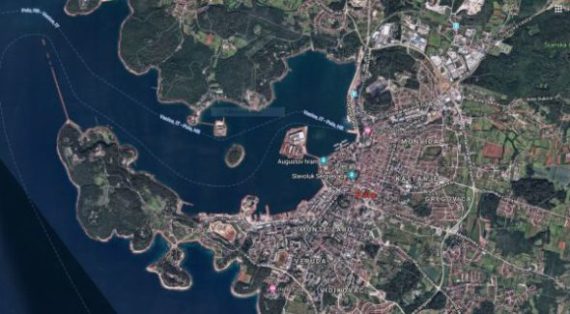
The timing of this adventure was unfortunate, as negotiations were underway toward an armistice which was signed at the Villa Giusti near Padova on November 3, 1918; the ceasefire was to go into effect November 4. But over on the Adriatic it was still war until further notice.
So on the night of November 1, 1918, Raffaele Paolucci and Raffaele Rossetti each took hold of a new device called a mignatta, an ingenious motorized underwater torpedo-like cylinder (constructed in the Arsenal in Venice) which rapidly carried them underwater past sentinels, patrol boats and even a submarine. After six hours in the water, they were finally close to the Viribus Unitis. At 5:30 they managed to attach the 200-kilo bomb to the ship’s hull, programmed to explode at 6:30. No escape, though — searchlights found them and they were captured.
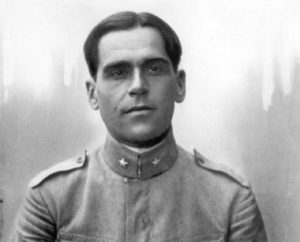
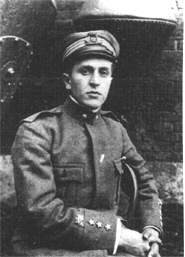

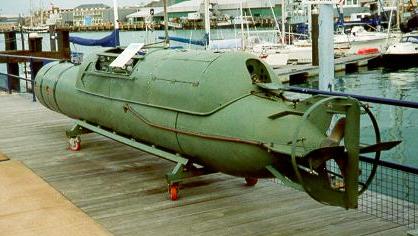
At 6:00 they advised the commander of Viribus Unitis that the ship was mined and would explode at 6:30; the crew was ordered ashore, Paolucci and Rossetti were sent as prisoners to the nearby Tegetthoff, the bomb didn’t explode, the crew returned, and the bomb detonated at 6:44 leaving 300 men either dead or lost, including the captain, and sinking the ship (obviously).
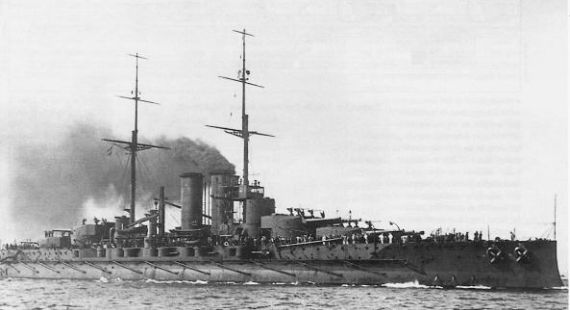
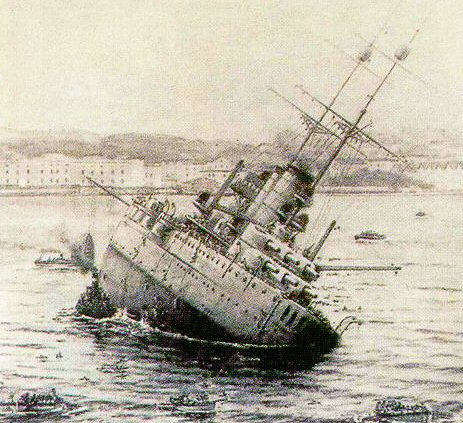
On November 5 the Italian Royal Navy occupied the port of Pola and freed Paolucci and Rossetti.
The fate of the dreadnoughts: Szent Istvan was gone forever; the wreck of the Viribus Unitis was salvaged and broken up between 1920 and 1930; Prinz Eugen was ceded to France where she was sunk as a target ship in 1922; and the Tegetthoff was given to Italy and scrapped between 1924 and 1925.
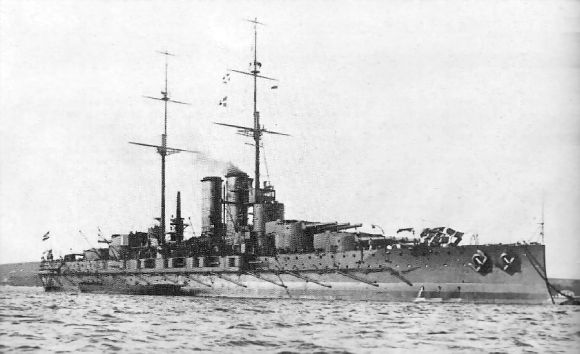
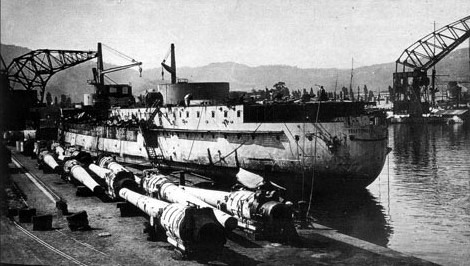
Luigi Rizzo died in 1951, two months after an operation to remove a tumor on his lung. The surgeon was none other than his friend and fellow dreadnought-slayer, Raffaele Paolucci.
